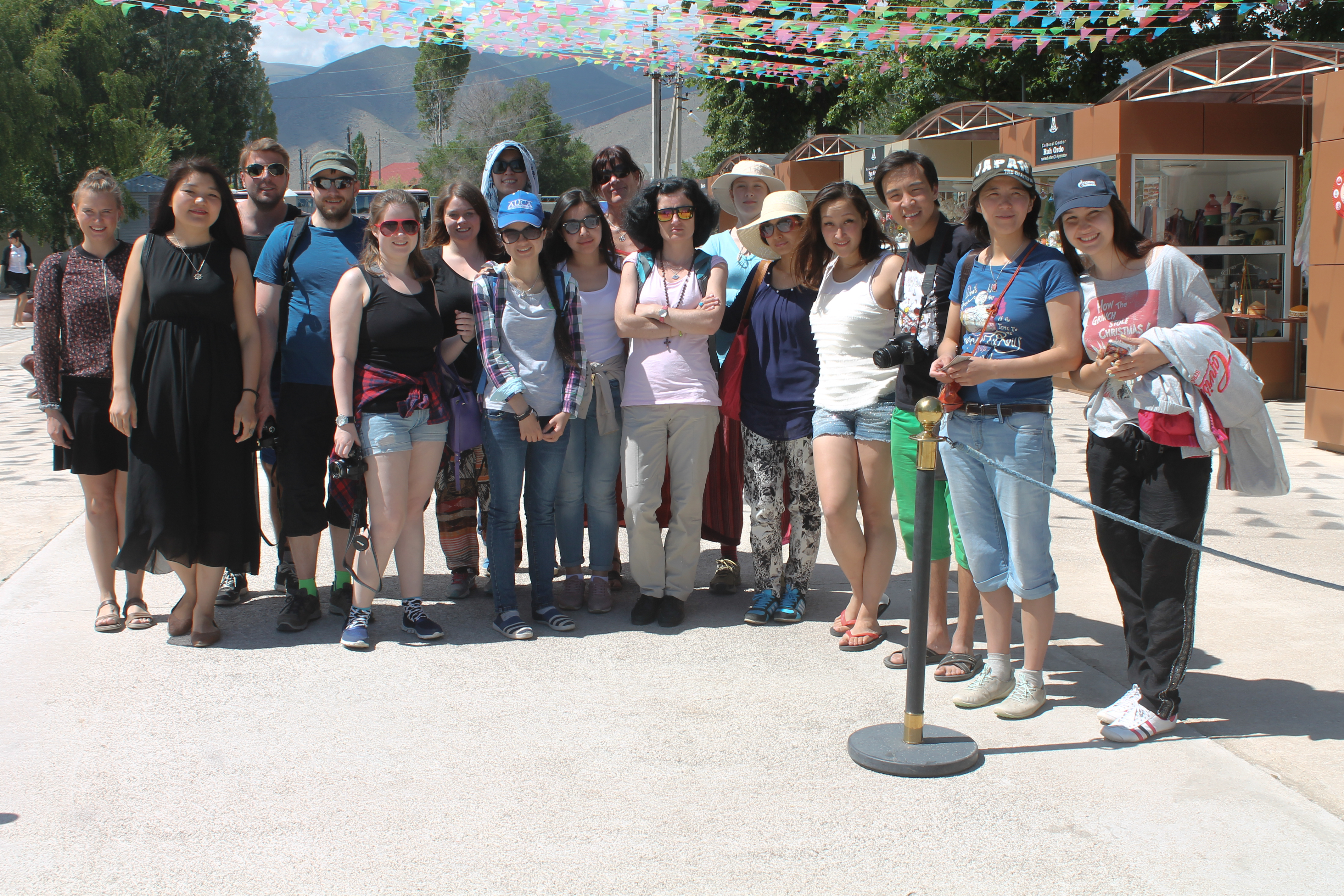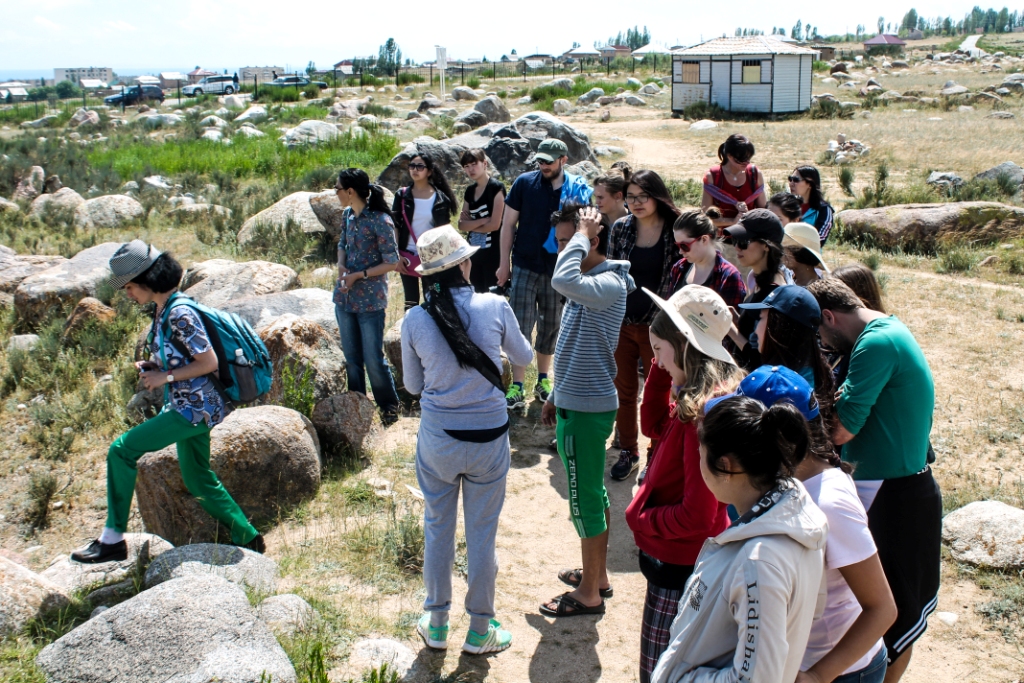July 8, 2015
The Anthropology Department of the American University of Central Asia together with the University of Tromso of Norway implemented the joint project “A Comparative Perspective on Cultural Ecology and Nomadic Life in Central Asia and Norway” in Kyrgyzstan’s “Akun Issyk - Kul” Resort, Kara-Oi village, from June 14 to 23, 2015. This unique summer school program was attended by seven students from the Anthropology, Sociology, and NGA Departments of AUCA as well as six students from Tromso University.
The main goal of the project was to introduce these foreign and local students to the traditional lifestyles and cultures of Central Asia and Norway through a series of lectures, workshops, and master classes. Moreover, the students of AUCA and Tromso University not only learned from classroom lectures but were also able to undertake fieldwork on various topics in the Cholpon-Ata area.

One of the participants of the summer school, second-year student Gulnora Iskandarova of AUCA’s Anthropology Department, told us about her experience:
“The program of the summer school was academically informative and full of activities. During the first four days, there were lecture presentations made by the professors of AUCA and Tromso University on various topics such as the ethnogenesis of the Kyrgyz people, archaeology of Kyrgyzstan, nomadic pastoralism, kinship, Islam, and interethnic relations in Kyrgyzstan.
During the first day, we were lectured about “Ethnogenesis and Formation of the Kyrgyz Ethnic Group” by Cholpon Chotaeva, Professor of Anthropology at AUCA. She told us not only about the history of Kyrgyz ethnic people, but also about different ethnic groups who lived on the territory of Kyrgyzstan from the Stone Age till nowadays. The next lecture “Archaeology of Kyrgyzstan” was taught by the specialist on Stone Age of Kyrgyzstan Aida Abdykanova, Associate Professor of Anthropology at AUCA, where she told about archaeological sites of Kyrgyzstan dated back from the Stone Age till Late Middle Ages. In the second half of the day we had master class in the Museum of Cholpon–Ata city, where we were demonstrated archaeological and cultural artifacts of that area as well as the Manas Epic performance of 10-year old famous Manas reciter Umot Doolotov. It was one of the most fascinating experiences during the summer school. The performance of Manas reciter was so impressive that some people believed that Manaschi were not ordinary people who learnt the epic by heart but especial ones with supernatural abilities.
On the second day we had lectures on “Nomadic Pastoralism in a Changing World: A Comparative Approach” presented by Marius Warg Naess, the Tromso University researcher, where he compared nomadic pastoralist communities in Tibet, Norway, and Central Asia and showed how they developed throughout the history under different political and ecological conditions. The next lecture was about “Sedentarization of Kyrgyz Nomads in 1920 – 30s: Oral Histories, Approaches, and Theoretical Debates” by Ruslan Rahimov, Associate Professor of the Anthropology Department. He familiarized students with the specific and significant dates of the Kyrgyz nomadic people when their lifestyle changed from nomadic to settled, as well as problems and difficulties they faced during the transitional period.
In the afternoon, we visited the Rock Art sites of Cholpon–Ata city and Ornok village, where we observed petroglyphs left by various ancient communities lived there in different periods of time. The site Ornok village, where the workshop took place, was a beautiful ancient stony place with a lot of drawings of deers. Aida Abdykanova told the history and usage of this place by Kyrgyz ancestors who worshiped the deer. According to her, it was the only place in Central Asia with so many deers depicted on the stones. Probably this fact makes Kyrgyzstan even more special and unique among other Central Asian countries.

In the third day, in accordance with the program, the participants of the summer school listened to two presentations. The first presentation was about “Education, Culture, and Mobility” by Jennifer Hays, Professor of Anthropology at Tromso University. She presented her long-term research on nomadic tribes in Africa and tried to answer to the main question “What does formal education mean for nomadic groups?” through cultural perspective. Since my interest was also on education, I found out that her lecture answered my questions too and could be a good start for my own research on education. More interesting information was about formalized herding education in Norway which was very popular among Sami people who were indigenous nomadic pastoral community in Norway. This fact was interesting and at the same time unusual for me because although there was developed pastoralism in Kyrgyzstan and people still practiced nomadic lifestyle and herded animals, they did not study how to do it at schools but were taught informally in their families since early childhood.
Next presentation was “The Role of Kinship and Family Ties in Present Kyrgyzstan and Central Asia” by Cholpon Turdalieva, the Professor at Anthropology Department, historian. She told us about how kin relationship was constructed in the Kyrgyz community. After the lectures finished we visited the Ruh Ordo Museum named after Chyngyz Aitmatov in Cholpon–Ata city, where we were informed about various works of our great writer Chyngyz Aitmatov and other cultural and political figures of Kyrgyzstan and the CIS.
On the fourth day of the summer school we had the lecture “Islam in Modern Kyrgyzstan: The Role of Tablighi Jama’t Network” by Mukaram Toktogulova, Professor of Anthropology. She presented the history of formation and development of Tablighi Jama’t community in Kyrgyzstan and explained how it is practiced among the Kyrgyz people. She explained the main goal of the religious movement, why this religious network became popular not only in Kyrgyzstan but also in other countries, and why Kyrgyzstan was the only Central Asian country where Tablighi movement was not prohibited.

After lectures we had a master class on Kyrgyz music where the Kyrgyz komuz player Bahtiyar performed different melodies and sang Kyrgyz songs. Moreover, he told the history and demonstrated the structure of komuz, such as what wood is used to create the instrument, how to play, the differences and uniqueness of komuz compared to other Central Asian musical instruments, and etc. In addition, the students from Norway shared their experience of Norwegian musical instruments with the participants of summer school trying to find similarities and differences in both countries.
The remaining days of summer school were dedicated to group fieldwork projects, where 13 students from AUCA and Tromso University were divided into 5 groups and conducted their own fieldwork projects applying observation and interviewing methods in Kara–Oi village and Cholpon–Ata city, the pastures of Tegerek, Grigorevka and Semenovka villages. The topics of fieldwork projects covered different issues such as archaeology of southern Issyk–Kul, language policy and situation in the Issyk-Kul area, the role of women in Kyrgyz families, Kyrgyz nomadism and its mobility, cooperation, culture, informal and formal education by comparing it to Norwegian and other nomadic communities. While conducting fieldwork, we used the knowledge and information received from lectures and master classes, thereby the results of their findings were presented during the last day of the summer school, on June 22.
For me, these 10 days of summer school passed really fast thanks to the well-prepared program which was academically informative and full of interesting activities such as master classes, tours to historical and cultural places and fieldwork projects. As a popular Russian proverb says, “It is better to see something once rather than to hear about it hundreds of time”, this summer school was a great opportunity to observe the most interesting aspects of the Kyrgyz and Central Asian culture and lifestyle. Local and foreign students and faculty members were amazed by hospitality and generosity of Kyrgyz people who invited them inside yurts and offered a cup of kymyz. Moreover, they had a chance to witness how Kyrgyz people practice pastoral life by observing and interviewing them. Although I was a local student, I learned many new interesting things too about the nomadic lifestyle of the Kyrgyz, especially about their informal education.
I think that the joint project of AUCA and Tromso University “A Comparative Perspective on Cultural Ecology and Nomadic Life in Central Asia and Norway” was extremely successful. I am really glad that I participated in this Summer School organized by AUCA and Tromso University. I am thankful to the Anthropology Department of the American University of Central Asia for this unforgettable experience. For me, this summer school was a very good and interesting experience that resulted in the exchange of knowledge and skills on culture and lifestyle of Kyrgyzstan and Norway looking from a comparative and interdisciplinary perspective. Thanks to it, I have learned and discovered many new things, made new friends and spent awesome time at the Issyk-Kul Lake.”